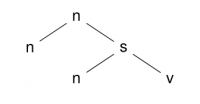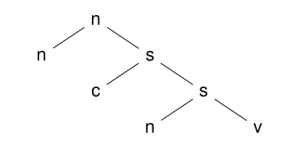-
Notifications
You must be signed in to change notification settings - Fork 2
5: Examples
Now, we will see in details how to write a metagrammar. We will define a metagrammar generating a small TAG for French. This small TAG will contain 2 trees, namely the ones representing a transitive verb either with a canonical subject or a subject in relative position.
First thing to do: defining the principles, types, properties and features we will use. For the sake of clarity, we will only constraint the produced trees to have no duplicate grammatical function. That is to say, we will only activate the unicity principle with the gf property as parameter:
use unicity with (gf = subj) dims (syn)
use unicity with (gf = obj) dims (syn)
We will deal with few types in this example. We only pay attention to grammatical functions and syntactic categories. The first one is a node property and the second one a node feature (ie part of the TAG formalism):
type CAT = {n,v,s}
type GF = {subj, obj}
property gf : GF
feature cat : CAT
The metagrammatical rule we will use is the following:
transitive = (CanSubject | RelSubject) ; Active ; Object
So we will handle 4 tree fragments: Active, CanSubject, Object, and RelSubject. The class transitive will consist of an abstraction on a conjunctive combination including a disjunction on the subject that is used. The Active class corresponds to the verbal spine:

class Active
export ?X ?Y
declare ?X ?Y
{`<syn>`{
?X -> ?Y
}
}
The CanSubject class corresponds to the Example class introduced previously:

class CanSubject
export ?X ?Y ?Z
declare ?X ?Y ?Z
{ `<syn>`{
node ?X [cat = s]{
node ?Y (gf=subj)[cat=n]
node ?Z [cat = v]
}
}
}
The Object class is the symetric class of CanSubject:

class Object
export ?X ?Y ?Z
declare ?X ?Y ?Z
{ `<syn>`{
node ?X [cat = s]{
node ?Y [cat = v]
node ?Z (gf=obj)[cat=n]
}
}
}
The RelSubject class and its concrete syntax are given below:

class RelSubject
export ?X ?Y ?Z
declare ?X ?Y ?Z ?U ?V
{ `<syn>`{
node ?U [cat = n]{
node ?V [cat = n]
node ?X [cat = s]{
node ?Y (gf=subj)[cat=n]
node ?Z [cat = v]
}
}
}
}
At this point, we may wonder why associating variables to nodes ? The answer is that we still have to merge these fragments, we will use the exported variables to unify specific nodes.
Once the basic blocs have been defined, we can combine them to produce the expected trees. We define the transitive class:
class transitive
declare ?SU ?OB ?AC
{
?SU = {CanSubject[] | RelSubject[]} ; ?OB = Object[] ; ?AC = Active[] ;
?SU.?X = ?OB.?X ; ?SU.?Z = ?OB.?Y ; ?SU.?X = ?AC.?X ;
?SU.?Z = ?AC.?Y
}
In this class, we use the dot operator to associate a variable to the record of exported identifiers. For instance, ?OB being the variable representing the Object class, ?OB.?X refers to the ?X variable of this class, provided it has been exported. In the transitive class we combine conjunctively 3 classes (one being either CanSubject or RelSubject, and Object, and Active). We also unify their s and v nodes so that the tree fragments get merged. Note that we may prefer using a color system to semi-automatize this node unification (see Controlling fragment combination semi automatically by coloring nodes). Eventually, we know that the transitive class contains all the information needed to build 2 TAG trees. So we ask for its evaluation by invoking:
value transitive
As a result we obtain the 2 following trees (the first one represents the relative subject, and the second one the canonical subject) :


use unicity with (gf = subj) dims (syn)
use unicity with (gf = obj) dims (syn)
type CAT = {n,v,s}
type GF = {subj, obj}
property gf : GF
feature cat : CAT
class Active
export ?X ?Y
declare ?X ?Y
{`<syn>`{
?X -> ?Y
}
}
class CanSubject
export ?X ?Y ?Z
declare ?X ?Y ?Z
{ `<syn>`{
node ?X [cat = s]{
node ?Y (gf=subj)[cat=n]
node ?Z [cat = v]
}
}
}
class Object
export ?X ?Y ?Z
declare ?X ?Y ?Z
{ `<syn>`{
node ?X [cat = s]{
node ?Y [cat = v]
node ?Z (gf=obj)[cat=n]
}
}
}
class RelSubject
export ?X ?Y ?Z
declare ?X ?Y ?Z ?U ?V
{ `<syn>`{
node ?U [cat = n]{
node ?V [cat = n]
node ?X [cat = s]{
node ?Y (gf=subj)[cat=n]
node ?Z [cat = v]
}
}
}
}
class transitive
declare ?SU ?OB ?AC
{
{ ?SU=CanSubject[] | ?SU=RelSubject[] } ; ?OB = Object[] ; ?AC = Active[] ;
?SU.?X = ?OB.?X ; ?SU.?Z = ?OB.?Y ; ?SU.?X = ?AC.?X ;
?SU.?Z = ?AC.?Y
}
value transitive
More examples can be found in the Metagrammars folder of the XMG installation directory. Some grammars are also available on the resources page of the XMG website.